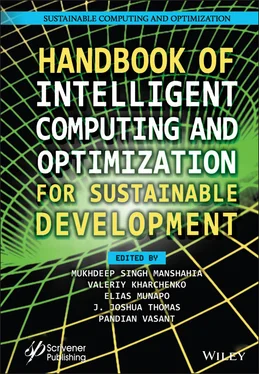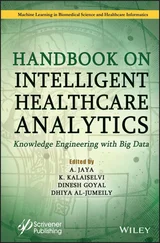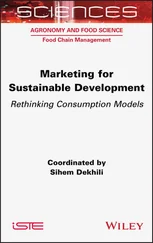• Step 10: The output strand C is released.
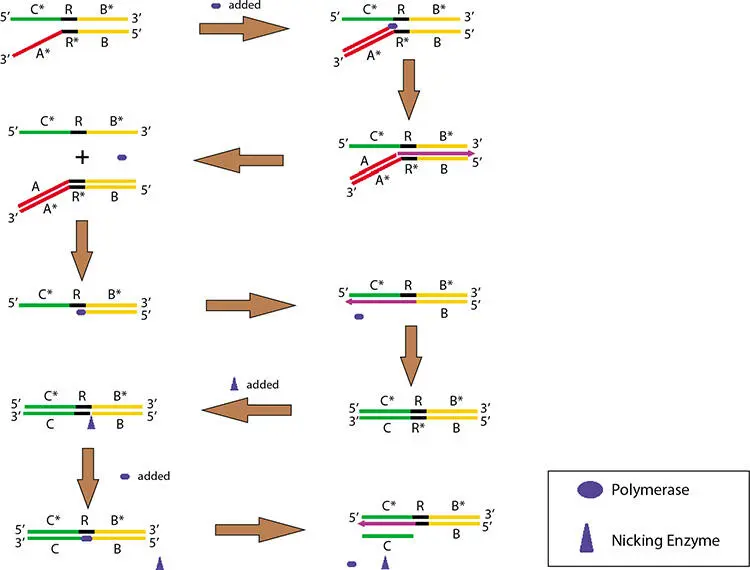
Figure 2.20 AND reaction.
By repeating the steps 8, 9, and 10, the output strand C can be amplified and released.
Let the input variables of the OR gate be a and b and the output variable be c . The strands A , NA are prepared for the variable a ; strands B , NB are prepared for the variable b ; strands C , NC are prepared for the variable c . The OR reaction can be represented by A | B → C where the strand C is produced if and only if either of the strands A or B exists in the solution. The AND reaction NA ∧ NB → NC also implements the OR gate. The OR reaction is explained by the following steps (see Figure 2.21) [9].
• Step 1: The reaction solution contains OR complex and sufficient amounts of input DNA strands A and B. The OR complex initially consists of a single stranded DNA sequence 5’-C*-R-B*-A*-3’.
• Step 2: The single stranded DNA A or B, which acts as primers, hybridizes to A* or B* of the OR complex. In Figure 2.21, A hybridizes to A*. Then, DNA polymerase binds this double-stranded part.
• Step 3: DNA polymerase elongates the sequence A until it reaches to the 5’-end of the sequence 5’-C*-R-B*-A*-3’.
• Step 4: A complete double-stranded DNA sequence is formed.
• Step 5: This sequence is recognized by a nicking enzyme at the site R and R*, and it cleaves the strand R*.
• Step 6: DNA polymerase, while pushing the strand C away, elongates the strand 5’-A-B-R*-3’ again until it reaches to the 5’-end of the sequence 5’-C*-R-B*-A*-3’.
• Step 7: The output strand C is released.
By repeating the steps 5, 6, and 7, the output strand C can be amplified and released.

Figure 2.21 OR reaction.
2.5.3.3 PROPAGATE (PROP) Reaction
Let the input variable of the PROP reaction be a and the output variable be b . The strands A , NA are prepared for the variable a ; strands B , NB are prepared for the variable b . The PROP reaction can be represented by A → B where the strand B is produced if and only if the strand A exists in the solution. The PROP reactions A → NB and NA → B implement the NOT gate. The PROP reaction is explained by the following steps (see Figure 2.22) [9].
• Step 1: The reaction solution contains PROP complex and sufficient amount of input DNA strand A. The PROP complex initially consists of a single stranded DNA sequence 5’-B*-R-A*-3’.
• Step 2: The single stranded DNA A, which acts as primers, hybridizes to A* of the PROP complex. Then, DNA polymerase binds this double-stranded part.
• Step 3: DNA polymerase elongates the sequence A until it reaches to the 5’-end of the sequence 5’-B*-R-A*-3’.
• Step 4: A complete double-stranded DNA sequence is formed.
• Step 5: This sequence is recognized by a nicking enzyme at the site R and R*, and it cleaves the strand R*.
• Step 6: DNA polymerase, while pushing the strand B away, elongates the strand 5’-A-R*-3’ again until it reaches to the 5’-end of the sequence 5’-B*-R-A*-3’.
• Step 7: The output strand B is released.
By repeating the steps 5, 6, and 7, the output strand B can be amplified and released.
The researchers experimentally proved that the proposed method is more time-efficient than DNA strand displacement approach. Also, the output of each DNA logic gate can be amplified, and so, the scalability and the feasibility of the proposed system are better than other methods.
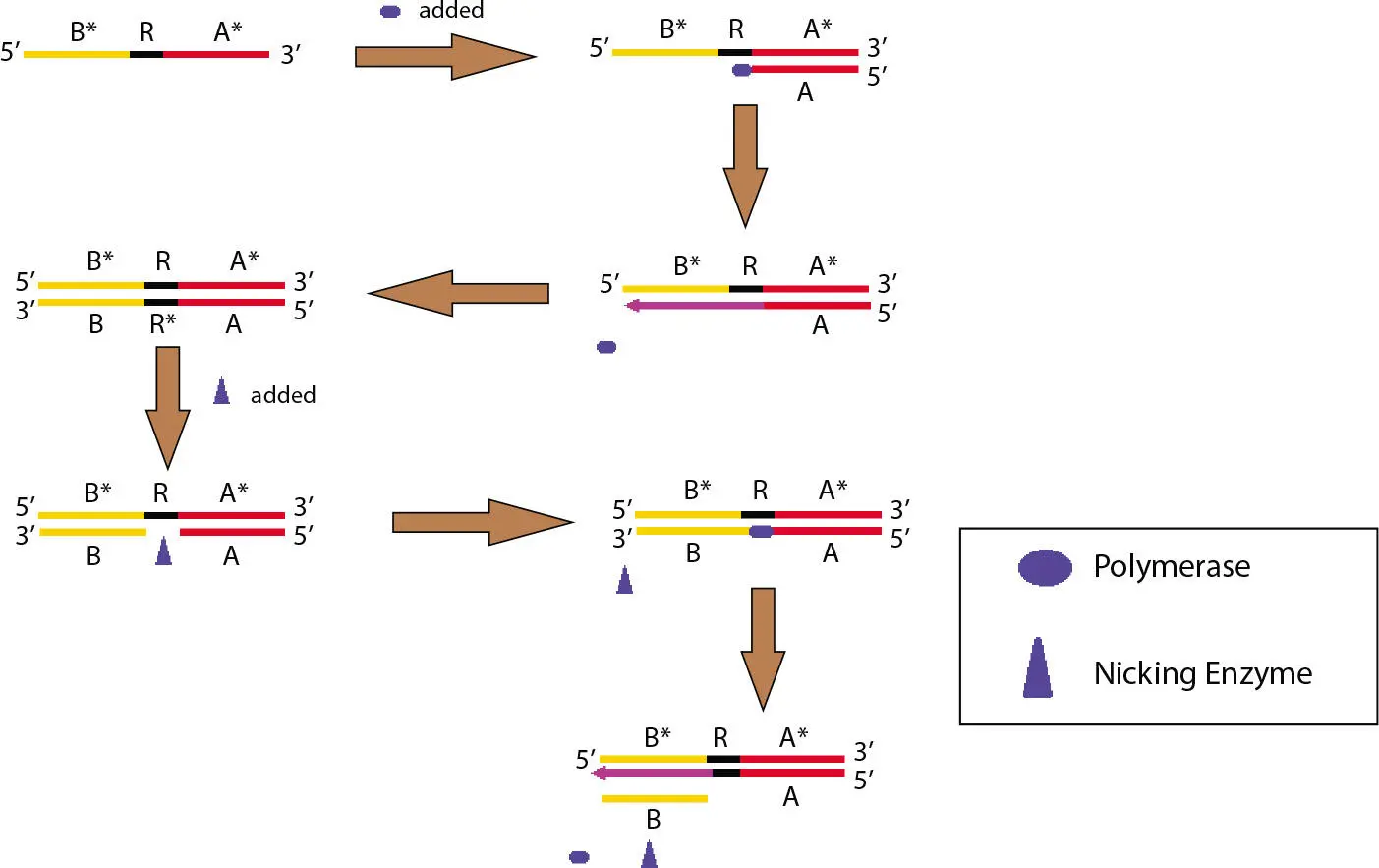
Figure 2.22 PROP reaction.
But the method has a problem that the amplification of the output strands continues until DNA polymerase uses up the substrates. So, a bio-lab method for stopping or inhibiting the amplification process is needed in this framework.
In the next subsections, we focus on the applications of DNA logic gate in real life. Researchers have used the DNA logic gates to develop the nano-device with artificial intelligence, which can play tic-tac-toe game. The logic gates also have medical applications which we are going to illustrate.
2.5.4 Applications of DNA Logic Gate
Researchers have successfully developed logic gate using DNA strands and enzymes which is the basic requirement to design nano-DNA-devices. The scientists are approaching toward the generation where these nano-machines can be implanted in living organisms so that it could sense the conditions and accordingly can make decisions and respond to the situation. Based on the sensed circumstances, the nano-devices would be able to take required actions, for example, releasing medicines and killing hazardous cells.
Qian et al . [10] proposed DNA gate architecture using seesaw gate motif which is used to develop linear threshold circuits. Using DNA strand displacement cascades, the researchers projected autonomous chemical systems which are competent to recognize patterns of molecular events and accordingly make decisions and responds to the odd situation.
Cherry and Qian from Caltech publicized [11] that they have successfully designed ANN from synthetic oligonucleotides. Based on the designing criterion of DNA circuit, i.e., predictable hybridization rules and biochemical reactions of the DNA strands, Cherry and Qian developed ANN which can perform computing tasks, for example, molecular pattern recognition.
2.5.4.1 Playing Tic-Tac-Toe by DNA
Tic-tac-toe (noughts and crosses), which is one of the world’s oldest games, is played by two players. The playing board is a 3 × 3 grid of 9 squares. It is displayed first, showing all slots empty. Each player is assigned a mark, either × or 0. The × player usually goes first. Two players alternatively places × and 0 on the board until it satisfies either of the two conditions listed below:
1 i. one player succeeds to place three respective marks in a row horizontally/ vertically/diagonally; the player is the winner;
2 ii. all nine squares are filled; the game is a tie.
In 1840s, Charles Babbage invented an automaton that is capable of playing tic-tactoe. It was one the first games which has been electronically coded on computer. In 1952, A. S. Douglas developed this video game on the Electronic Delay Storage Automatic Calculator (EDSAC) at the University of Cambridge.
A group of researchers from Columbia University and the University of New Mexico designed an interactive molecular machine with series of wells which are filled with hairpin-shaped DNA strands [12]. These nano-device is capable of playing tic-tac-toe game but with restricted moves. The molecular device is named as molecular array of YES and ANDANDNOT gates, or MAYA. This system is four times more complex than any previously designed DNA computer and the most powerful demonstration of DNA computing till date. It is also the first interactive use of programmable DNA enzymes.
Читать дальше
